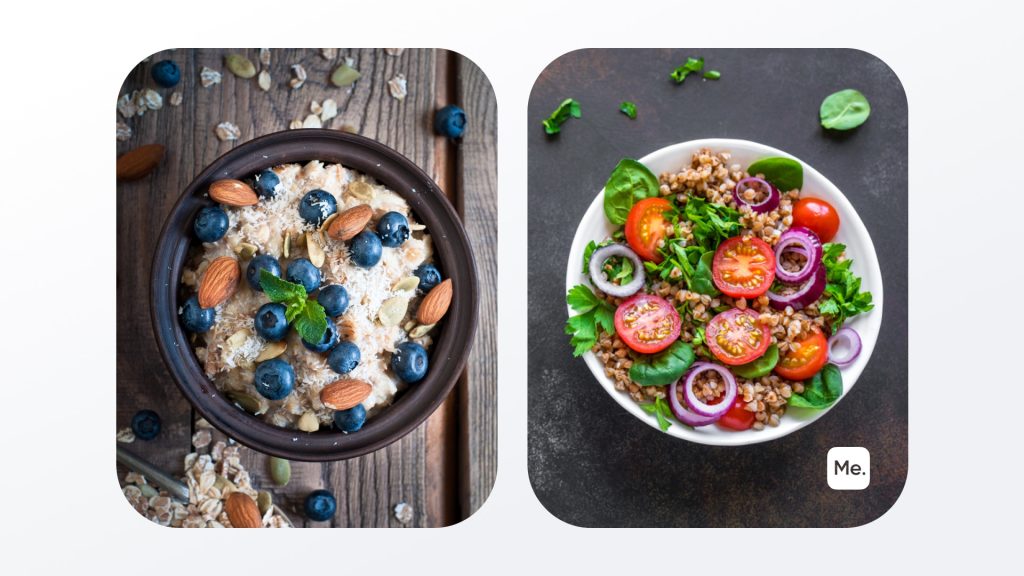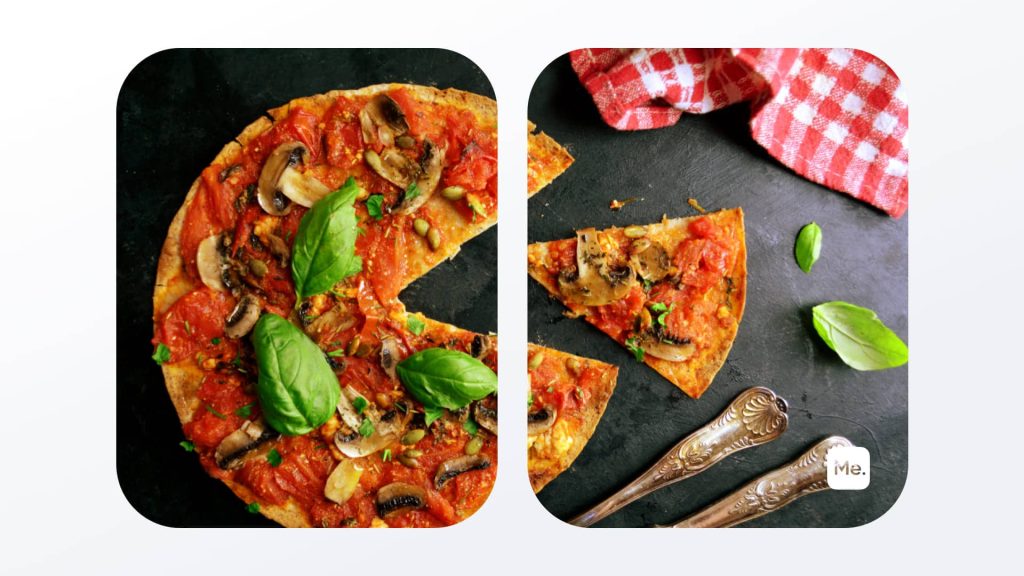Dieting can be exhausting, and with the many types of diets circulating on social media, no doubt you need a break from them. What’s more, you can diet and lose those extra pounds, but it gets harder to maintain the weight. Intuitive eating is the solution. Following the 10 intuitive eating principles discussed below, you can break this cycle of constant dieting and finally reconnect with your body. You learn to listen and follow your body’s natural hunger, fullness, and satiety cues leading to improved health and psychological well-being.
Get your personalized
meal plan!
What Is Intuitive Eating?
Intuitive eating is a different approach to healthy eating that focuses on nourishing the body how you see fit. Your impulse to eat or stop eating is what guides your feeding habits, seeing as you will solely depend on your body’s hunger and fullness cues to guide you.
With intuitive eating, you experience a different approach to nutrition that has no restrictions, no meal plans, no forms of dieting that could limit your body’s well-being. The eating style promotes a healthy attitude towards food and body image rather than focusing on weight loss.
History Of Intuitive Eating
Intuitive eating was originally developed by two dietitians, namely: Evelyn Tribole and Elyse Resch, back in 1995 when they authored a book called Intuitive Eating: A Revolutionary Non-Diet Approach. As of now, it has four editions, but the root concept remained that intuitive eating was in no way like dieting as this approach offered freedom to eat and explore different foods without guilt or condemnation.
The book had its pioneers, such as Susie Orbach, who published “Fat is a Feminist Issue” in 1978. Geneen Roth, who has written about emotional eating since 1982; and Thelma Wayler, who founded a weight management program in 1973 called Green Mountain at Fox Run, based in Vermont.
They all had the idea that to achieve long-term health; you need to focus on lifestyle changes and self-care rather than dieting.
Read More: Intuitive Eating: A Philosophy That Is All About Listening To Your Body
Difference Between Intuitive Eating And Mindful Eating
These two terms are often used interchangeably, but they shouldn’t be. Mindful eating is being aware of the positive and nurturing opportunities available through food selection and preparation by respecting your inner wisdom. Through your cues, you eat satisfying and nourishing foods and stop when you’re full.
Intuitive eating works the same way but encompasses much more detail, hence the 10 principles of intuitive eating we shall read about in the next segment. These principles will guide you on respecting your body’s image, rejecting the diet mentality, and what it means by gentle nutrition.
Therefore mindful eating is engulfed in intuitive eating, and intuitive eating also has scientific proof that ascertains its benefits.
What Are The 10 Principles Of Intuitive Eating?
To be an intuitive eater, you have to understand every one of these principles below. Let’s begin.
Reject The Diet Mentality
The diet mentality is an idea/ belief that there’s a diet out there that can help you achieve your best self. Whether it’s a more toned body, losing weight, accepting God, or for whatever reasons. These feeding disciplines limit you from discovering the true power of food; how nourishing and satisfying it can be.
One thing you should learn is that we’re born intuitive eaters. As a child, you would cry out for food when hungry and stop eating when you’re full. You had the freedom to eat more on some days and eat less on others, depending on your cues. That’s what intuitive eating means, that food is a necessity to fuel your body and not a privilege or something to limit as with dieting.
Because intuitive eating has no strict instructions, no meal plans/ recipes, no limitations, it can be confusing, overwhelming, and daunting for you. But you can relearn how to trust yourself again because otherwise, getting too caught up in diet mentality can affect your mental health and even lead to eating disorders, particularly anorexia and bulimia (4).
To reject the mentality, you start by getting rid of magazines, papers, and unfollowing social media accounts that encourage you to diet. Other things you can do include:
- Identify your trigger and challenge it. For example, do you diet as a coping mechanism to stress, or perhaps to lose weight based on influence from relationships and social life?
- Reflect on why you choose to keep dieting. Was it beneficial, or did you maintain the cycle because you were afraid to change?
- Educate yourself to break the cycle. There are other complimentary books to intuitive eating that you can read, for example, Health at Every Size.
Looking for a way to break the vicious cycle of weight loss and tone up all the jiggly parts? Watch the extra pounds fly off and your muscles firm up with the BetterMe app!
Honor Your Hunger
Hunger is a normal biological process of the body. It’s a sign that your body needs fuel to continue functioning. By honoring your hunger, you feed your body when it needs it and however much it needs.
Of course, with intuitive eating, you’re allowed to eat even when you “shouldn’t be” hungry because, again, this approach isn’t supposed to be like dieting, where you eat at specific times or moments of the day.
-
Types Of Hunger
One of the characteristics of intuitive eating is that you should listen to your hunger cues but follow physical hunger. Let’s have a look at these four types:
- Physical. It’s a natural sign from the body that you need replenishment. You’re likely to experience the physical symptoms of hunger, such as a gnawing stomach and fatigue.
- Emotional hunger. It stems from emotional cues such as anxiety, anger, comfort, or distraction. You often feel this after an outburst of intense emotions.
- Taste hunger. It’s more like a craving or the news to taste and eat something even when you’re not hungry. For example, if you crave dessert after a meal.
- Practical hunger. Here’s a type of hunger that you anticipate rather than feel. For example, if you’re eating before a long trip, after a strenuous workout, or before medication.
-
How To Honor Your Hunger
In intuitive eating, you should eat when you’re hungry or when the cue arises. Whenever you experience the signs of hunger like tiredness, trouble concentrating, headaches, dizziness, irritability, or a growling stomach, listen to your body and eat.
You’re also allowed to eat when you’re not physically hungry, hence the case of taste and practical hunger. Again, you’re not restricted, and you can eat as you please to nourish and satisfy the body. Ensure that you eat enough throughout the day regardless of whether you’re pressed for time or not.
Honoring your hunger is vital because otherwise, your body loses touch with its cues which could lead to increased cravings, binge eating, and chaotic eating habits. Furthermore, such eating habits may lead to bloating and indigestion. To avoid that, acknowledge the effects of hunger and act on them
Make Peace With Food
Food shouldn’t be your enemy. No food is good or bad, nor should you have a list of foods to eat or foods to avoid, unless by preference. Intuitive eating encourages you to eat whatever you want without limitations. If you restrict certain foods, you will feel deprived, leading to cravings and overeating.
Learn to make peace with food that was otherwise restricted to you and allow yourself to be fully immersed in whichever food you want. Doing so relieves you from feelings of guilt. To let yourself love food once more, resist your food lists and, one by one, begin to eat them again, starting with what you considered bad for you to what’s comfortable.
Read More: Losing 50 Pounds In 3 Months: Is It Possible?
Challenge The Food Police
The food police are those voices and thoughts that disrupt you from obeying your body’s intuitive cues. They tell you what to eat, how much, and what time to eat. These voices manipulate you to count calories or macronutrients down to the last gram to ensure you don’t eat more than you should.
By challenging these voices, you remove obstacles to the interoceptive awareness that food builds, develops, and nourishes the body rather than destroys and makes you fat. Take away these obstacles that induce guilt and deny you the satisfaction of eating with freedom.
To challenge the food police, start by creating a mindful eating worksheet that highlights all the foods you want to eat. Include them in your new meal plans that feature healthy and nourishing macronutrients without limiting the quantity or the time you eat.
The worksheet will help you discover a new world of food where you plan, cook, and eat what you want when you want to eat and however you want to eat.
Respect Your Fullness
We’ve talked about honoring your hunger. Now, this is the other end of the spectrum. Dieting affects your hunger and satiety cues because you follow a set schedule regardless of whether you’re hungry or not or if you’re full or not.
In intuitive eating, respecting your fullness is about appreciating the food that you’ve eaten and stopping until your next meal. Ideally, that’s how it should be, but this approach isn’t as rigid as dieting since you’re allowed to go overboard once in a while, especially when you’re enjoying your meal.
So by respecting your satiety signals, you acknowledge that you can have the meal another time without restrictions; this way, no need to binge eat. Again, if you don’t follow your fullness cue, you’re risking discomfort or bad eating habits.
-
How To Respect Your Fullness?
There are a few methods you can use to respect your fullness. The first and most prevalent is the hunger-fullness scale.
The Hunger-Fullness Scale
The scale runs from 1-10, where each number correlates to a different level of hunger or fullness. One represents extreme hunger, whereas ten is for excessive fullness. The scale is used to describe how you would feel at every stage and what it means for you.
- Ravenous. You’re painfully hungry and experiencing signs such as dizziness, fatigue, and nausea.
- Extremely hungry. You’re uncomfortable and have hunger pangs.
- Hungry. You require replenishment for the body.
- You’re thinking about food, maybe have an empty stomach, and have slightly lower energy levels.
- Neutral. You’re not hungry nor full.
- Mild fullness. You’re filled up but not full or satisfied.
- Satisfied but not uncomfortable.
- Slightly uncomfortably full
- You are stuffed/uncomfortably full. The feeling you get when you eat on Thanksgiving day.
- Painfully full. You’re so full you feel ill or nauseous.
How To Use The Hunger-Fullness Scale?
When you’re eating, take a pause and listen to your body. Are you full, satisfied, slightly uncomfortably full, stuffed, or worse? Ideally, you start at point three and aim for point seven, where you’re okay to wait for the next meal or move along with other activities.
The scale isn’t precise, but only a guide/ tool. Sometimes you can aim for level eight if you know you won’t eat anything else for quite some time. Also, you can go for a six if you’re eating before a workout; this way, you’re not uncomfortable in the process.
Other methods you can use to respect your fullness include:
- Practice meal immersion, where you approach your thoughts with curious awareness. You don’t have to get it right the first time, but you will get there with time.
- Eat privately. We have different capacities meaning our hunger and fullness cues can’t be equal. By eating alone, you learn to listen to yourself rather than how others are eating.
- The 3-Bite Option. It’s a similar method to the hunger-fullness scale, except in this case, you’re gauging your fullness yourself. Upon the 1st bite, note how you feel, whether pleasant, unpleasant, or neutral. Do the same for others until you achieve fullness.
If you tend to let yourself off the hook, raise the white flag when things get tougher than you expected, send yourself on an unconscious binge-eating trip – BetterMe app is here to help you leave all of these sabotaging habits in the past!
Discover The Satisfaction Factor
Satisfaction is the ultimate goal of the 10 principles of intuitive eating. The pleasure of enjoying, exploring, and living off eat-what-you-want diets until you’re satisfied. The power to satisfaction, or rather, the satisfaction factor, is realizing that you can be content with your food, and you don’t need diets to help you achieve that.
Being satisfied eliminates the need to overeat or overindulge in foods past your threshold. When you eat what you want, you get to enjoy the taste, acknowledge different flavors, and gain the feeling of pleasure that feeds the mental sensation of satiety.
-
How To Discover Your Satisfaction Factor?
The discovery may be daunting at first because there are so many options available to you, so you don’t know what to eat. But the key is to prepare foods that are fulfilling, tasty, and add pleasure. Here are some ways a satisfying meal may look like:
- Adding cheese
- Taking dessert after your meal
- Make sauces using the finest of ingredients.
- Adding butter for additional flavor
- Roasting your veggies rather than steaming
- Choose white over whole-grain foods if you prefer the taste.
Such things may not come so obvious to you, especially if you’ve been on low-carb/low-fat diets. So take it easy and experiment as you go along.
Honor Your Feelings Without Using Food
One of the biggest weaknesses of eating is emotional hunger. Instead of immersing your feelings in your food, why don’t you try other methods to deal with your feelings?
Food will never be the solution to an emotional problem but a mere distraction. So you have to learn to honor your feelings in other ways. These methods could be:
- Relaxation techniques such as mindful walking or mindful breathing.
- Taking yoga or exercise
- Talking out your problems either casually or professionally with a therapist.
- Meditate
- Indulge in a hobby like reading or watching television.
- Play with pets
These methods are easy methods you can use to cope with your emotions because you can’t always run away from them by eating.
Respect Your Body
A major reason for dieting is to achieve a good body. One way or another, you seek a better body, whether it’s more toned, slimmer, thicker, more built, and most commonly, less fat. It’s okay to want those things, but it should not be at the expense of food that nourishes the body.
By respecting your body, you learn to accept your body image through self-love and acceptance. Intuitive eating helps you achieve that because, as you know, one of the benefits of this approach is improved psychosocial behavior that builds on a positive body image and positive emotional functioning (2).
Learn to respect your body by caring for it, mentally, emotionally, and physically. Be kind and compassionate and accept its shape and size no matter how it looks. Feel good about yourself and realize that you are worthy and allowed to eat what you want without any guilt indictments.
Exercise – Feel The Difference
Nutrition is built on diet and exercise. With this approach to food, it’s the same. You’re encouraged to stay active, not because you want to lose weight or get those abs, but because it’s healthy and what your body needs to function effectively.
A study on adolescents revealed that exercising without dieting was associated with eating to satisfy physical hunger rather than emotional cues, which is an important concept in intuitive eating (3).. Besides the numerous benefits of exercising, movement allows your body to use up the different foods you eat so you don’t have to worry about eating too much that your body can’t handle.
These daily exercises you indulge in will allow you to build body stability by using up your intuitive eating calories the right way.
Honor Your Health – Gentle Nutrition
The last principle touches on gentle nutrition. What this entails is simply the food choices you make and how they contribute to better body health. The conscious decision that the food I’m eating will benefit and satisfy me
To practice gentle nutrition, endeavor to put your health first above anything else. It could be your mental or physical health. All in all, your health should be vital. Examples of ways you can incorporate gentle nutrition in your daily life include:
- Add fruits and vegetables to your meals because they offer essential nutrients to your body.
- Prepare and cook your meals at home using fresh ingredients.
- Follow healthy diets if you need to such as gluten-free for celiac disease or DASH diet for hypertension.
Conclusion
Intuitive eating is golden. There are no rules, no meal plans, and no restrictions. You solely rely on your body’s needs and trust that your body can lead you to your optimal path of acceptance. With intuitive eating, you learn to respect yourself, your body image, and your eating habits regardless of the outcome. That is the key to getting off your diet roller coaster.
DISCLAIMER:
This article is intended for general informational purposes only and does not address individual circumstances. It is not a substitute for professional advice or help and should not be relied on to make decisions of any kind. A licensed physician should be consulted for diagnosis and treatment of any medical conditions. Any action you take upon the information presented in this article is strictly at your own risk and responsibility!
SOURCES:
- A Review of Interventions that Promote Eating by Internal Cues (2013, sciencedirect.com)
- A systematic review of the psychosocial correlates of intuitive eating among adult women (2015, sciencedirect.com)
- Dieting, exercise, and intuitive eating among early adolescents (2013, pubmed.nih.gov)
- The Psychology Of Dieting (n.d., eating-disorders.org)
- The Ten Principles of Intuitive Eating – Evelyn Tribole (2003, intuitiveeating.org)
















